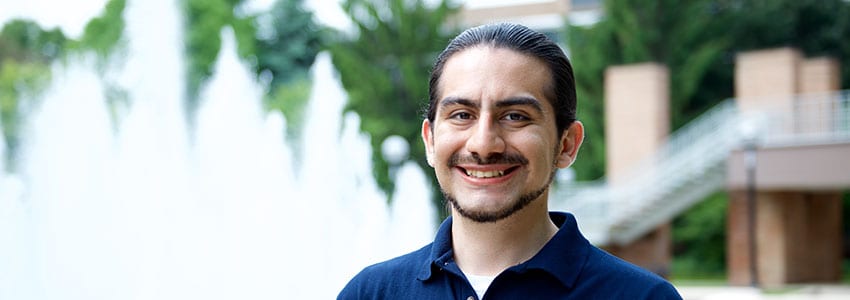For Mauro Rodriguez, a first generation high school student, college seemed like an impossible dream. The idea of attending – let alone graduating – was so far removed from his experience that it didn’t seem possible. Now a doctoral candidate in Mechanical Engineering, Mauro is driven by his roots to give back as much as he can.
He received inspiration and empowerment early on from faculty members as an undergraduate student at the University of Illinois at Urbana Champaign. “I was motivated early on to become like two of my Mechanical Engineering faculty members. I liked the way they thought about science and engineering, educated others, and had a character of helping others. That was the trifecta: being an educator, contributing to academic growth and giving back to the community.”
Mauro reflects, “U-M was absolutely the best choice. U-M has the technical breadth and depth that has expanded me beyond what I expected. This is the virtue of academic diversity. I’ve been grateful for how much U-M has been willing to invest in me. And there is good reciprocity; as I’ve been able to contribute so much here.”
Mauro plays with bubbles. Actually, it’s a little more technical than that. He investigates bubble dynamics and multi-component flows, inside tissue for example, to determine with high-fidelity what happens to surrounding tissue when bubbles vibrate and collapse both spherically and non-spherically. Using theory and computers, he examines the pressures, shear stresses, temperatures and conditions that ablate living tissue. He describes, “It is tricky business to correctly incorporate an equation such that it is accurate and can be put in a simulation or combination of equations that can capture bubble dynamics. We have to account for large density differences, such as that of water and air as well as pressure differences produced after the bubble collapses. My work figures how we handle simulations such that we can work with these variables, let alone the tissue itself. This research is of particular interest for the biomedical engineering and fluid mechanics communities as it has the prospects of becoming a powerful non-invasive ultrasound tissue ablation tool for treating breast and prostate cancer.”
A numerical approach to computing these kinds of problems is coming along fairly well, thanks to a multidisciplinary approach. Mauro comments, “Others have solved similar problems in different fields. There is great value in having intellectual depth and breadth: I can ask if some of the solutions others have figured out can apply to my problem. It adds and enriches my ability to look at my research from different perspectives.
Mauro and his advisor still have to publish this research, much of which will take shape as Mauro’s dissertation. He has two papers outlined now and the third will focus on application. He will enter the academic job market next year and is heavily invested in aspirations towards becoming a faculty member.
Most of Mauro’s work outside of the lab relies on his ability to ensure the socioeconomic uplift of his community. A self-described workaholic, Mauro is involved in the Society of Hispanic Professional Engineers, a national organization that is proactively providing developmental initiatives across the pipeline to attract, provide access, and support and develop Latinx students and professionals in Science Technology Engineering and Mathematics (STEM) fields. He explains, “We want to create a place where students learn how to do their best and develop self-reliance so they can graduate successfully. A lot of what I do outside the lab is this – giving back as much as I can, until the day that I die. I must make my body a bridge so that everyone in my community can walk across it. I’m very disciplined and resolved to provide the children of my community another example of what they are able to accomplish because I am and was just like them. This is what I’m meant to do.”
He’s been at U-M long enough to notice the gradual change towards increasing the diversity efforts, part of which he has played a role in shaping at the College of Engineering. He says, “I have great hope for the efforts being done here at U-M in regards to diversity. I am optimistic about the valiant diversity, equity and inclusion initiatives taking place across campus. Many dedicated individuals are passionately determined that powerful and measurable outcomes are achieved. Therein lies my optimism for these efforts as the stars don’t align for people; people align themselves to the stars. I am grateful to be here at U-M during these years of dedication towards its upward transformation.”
A 2016 inductee into the Bouchet Honor Society which honors the legacy of Edward Alexander Bouchet, the first African-American to be awarded a Ph.D. in the United States, Mauro says, “I found this to be an extremely humbling and privileged opportunity. I am immensely grateful. It allowed me to reminisce over the many things I’ve achieved thus far. From a young Chicano child growing up in a beleaguered but proud and honorable Mexican-American community in the southside of Chicago to where I am today. If anything, it reinforces for me why I must continue to be a servant leader for my Latinx community. I know how much work has yet to be done and am excited for that and that further empowers me.”

